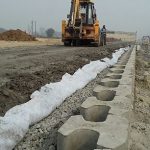
Geosynthetics have a variety of uses from erosion control to embankment reinforcement to improved subsurface drainage. One of the most common uses, however, is in road construction, particularly temporary roads such as construction roads, access roads and forest paths. These are the benefits of using geosynthetics for these applications.
· Bearing capacity
For constructing both roads and parking lots, it’s important subgrade is stable with sufficient bearing capacity. By using geogrids between the subsoil and base course, bearing capacity is increased. The interlocking of the cover soil with the geogrid provides horizontal force transfer, which serves to increase bearing capacity and, in many cases, allow for base course thickness to be reduced. This method also makes expensive soil exchange unnecessary.
· Rutting
One of the primary concerns when building unpaved roads on soft subsoil is rutting and inter-mixing of cover material into the subsoil. By improving load distribution, geogrids serve to minimize both rutting and soil intermixing. A specific project’s requirements will dictate the specifications of the geogrid needed.
· Force-elongation
Low elongation characteristics of a geogrid are needed for a successful reinforcement application. In many projects, force absorption at elongation requires a product with between 2-percent and 5-percent capacity. For more demanding applications, products with up to 8-percent elongation at break are available.
· Installation robustness
Finally, it’s important to consider a geogrid’s resistance to installation loads. High dynamic stresses can take their toll on reinforcement while installing and compacting cover soils and base course materials. To withstand this stress, a geogrid should have thick, monolithic reinforcement bars.
Using geosynthetics provides a more cost-effective and efficient method than many alternatives in a variety of applications. To learn more, or to find the geosynthetics required for your next project, come see us at Maxwell Supply of Tulsa.


